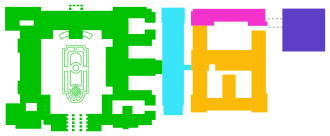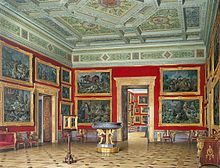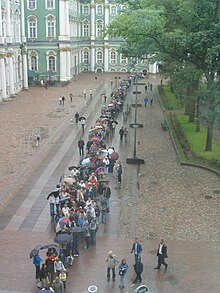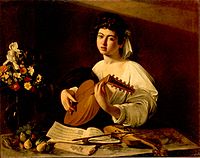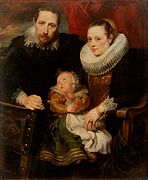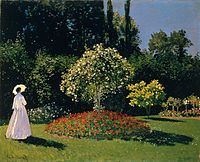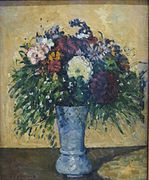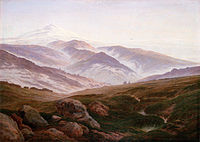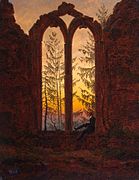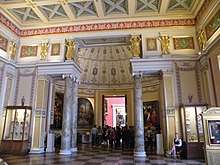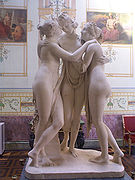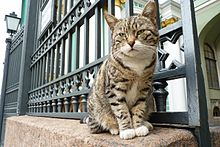Hermitage (Saint Petersburg)


On the feast of Epiphany , the tsar descended the imperial stairs to take part in the Great Consecration of the Neva , a celebration to commemorate the baptism of Jesus in the Jordan River .
The Hermitage [ eʁɘmiˈtaːʒ ] or Ermitage ( Russian Эрмитаж ) in Saint Petersburg on the Neva is one of the largest and most important art museums in the world. The building complex that houses the museum and to which the famous Winter Palace belongs is now collectively referred to as the Hermitage . He is a central part of the UNESCO - World Heritage declared St. Petersburg's city center.
The archive contains almost three million objects, including archaeological finds and the most important collection of classical European art alongside the Louvre and the Prado . Around 65,000 exhibits are on display in more than 350 halls. The paintings on display include works by Dutch and French masters such as Rembrandt , Rubens , Matisse and Paul Gauguin . There are also two paintings by the Italian universal genius Leonardo da Vinci and 31 paintings by the Spanish painter Pablo Picasso in the nearby General Staff Building. The museum has around 2,500 employees.
building
The name "Hermitage" comes from the old French and means hermitage . This is where the tsars withdrew from everyday political life in order to surround themselves only with art and muse.
Originally only the Small Hermitage and the subsequent Old Hermitage and the Hermitage Theater bore this name. Over time, due to the expansion of the imperial art collection, the buildings were enlarged and expanded in the 18th and 19th centuries. With the construction of the New Hermitage as a museum, the collection turned into a public museum and the name was used commonly for the entire building complex.
After the Russian Revolution of 1917, the neighboring Winter Palace , the former main residence of the Russian tsars , was also transferred to the museum and opened to the public. At the end of the 20th century the museum expanded again, in addition to the actual Hermitage complex, part of the General Staff Building (on the Palace Square opposite the Winter Palace) and the Menshikov Palace were added to the museum's premises.

Hermitage Theater - Old Hermitage - Small Hermitage (the New Hermitage is not visible behind it) - Winter Palace
Small Hermitage
The Small Hermitage by Jean-Baptiste Vallin de La Mothe , designed in the classicism style, was originally built between 1764 and 1775 as a refuge for Catherine II and is the smallest building in the ensemble. This is where Katharina put the first paintings she bought.
Old Hermitage
The Old Hermitage, also known as the Great Hermitage , was attached by Georg Friedrich Veldten in 1787 to accommodate the rapidly growing art collection. It is the most unadorned building in the complex.
Hermitage Theater
The Hermitage Theater was built from 1783 to 1787. The Emperor's Court Theater was the first theater in Saint Petersburg. It was recorded until 1796 and again from 1989; in winter the Kirov Ballet performs here . Today it serves primarily as an administration building, but also has a stage and an auditorium. The theater is the smallest in the city as it was originally only intended for private performances by the royal family. The Hermitage Theater is the only building in the Hermitage that is not normally open to visitors.
New Hermitage
Leo von Klenze , Bavarian court architect, built the New Hermitage as the last building between 1839 and 1852; it is perhaps the only one of his works that was created without the restrictive style requirements of Ludwig I of Bavaria and thus entirely according to Klenze's ideas. It is the only building that is not directly on the Neva . This building, too, was designed from the outset to house the art treasures of the continuously growing collection. In the New Hermitage there is a complete replica of a corridor actually designed by Raphael in the Vatican. The 10 telamons on the east portal made by AI Terebenjow with 150 sculptors and stonemasons in Serdabol granite are perhaps the most famous atlas figures of this type worldwide today .
Winter palace
The first Winter Palace was built in 1711 and over the years it was torn down and expanded several times. The current exterior corresponds to the renovation work by Bartolomeo Francesco Rastrelli (1754–1762). On December 17th, Jul. / December 29, 1837 greg. The Winter Palace burned out completely from a 30-hour fire inside. Emperor Nicholas I ordered a restoration of the residence to its previous condition, which was completed at Easter 1839. The current condition essentially corresponds to the condition of the building after the restoration. During the Great Patriotic War , the Winter Palace was damaged during the Leningrad blockade and then restored again. Today he is mainly affected by the large numbers of visitors, the lack of stability in the marshland and the moisture directly on the river. A renovation took place in 1984 and another in 2005.
history
Katharina II .: Foundation and first expansion
The Hermitage, both as a building complex and as an independent art collection, was founded by the Russian Empress Catherine the Great . In 1764 she bought 225 paintings from the Berlin art dealer Johann Ernst Gotzkowsky ; he had originally acquired it for the Prussian King Friedrich II , who, however , had to give up after the Seven Years' War due to the empty state coffers . In 1765 she bought almost 1,000 pictures for 80,000 thalers from Count Brühl's collection of paintings , the value of which was estimated at 105,329 thalers in his estate register.
The pictures were exhibited in the Winter Palace. Katharina also acquired important paintings, sometimes entire collections, both to satisfy her claim as a collector, and sometimes to emphasize the enlightenment and high cultural status of Russia and St. Petersburg in relation to Western Europe. The encyclopaedists Melchior Grimm , Denis Diderot and Russian diplomats such as Dmitri Golitsyn and Alexander Stroganow acted as their advisors in the acquisition of works of art . In 1775, Katharina had the architect JB Vallin de la Mothe build a small hermitage ( hermitage ) next to the actual palace in the style of the fashion of the time , in order to retreat here privately or in small groups - the later Small Hermitage . Soon a second larger building had to be added to accommodate the collection; today's Old Hermitage was designed in 1784 by the architect Veldten. At this time, plays were also being performed in the Small Hermitage; from 1783, Katharina had her own building, the Hermitage Theater, built for this purpose. Almost at the same time as these buildings, the Rafael Loggias , which are an exact replica of the Vatican Palace in Rome , were built on the quay of the Winter Canal . In 1797 the rapidly growing collection comprised 3,996 paintings.
Alexander I to Nicholas II: Further expansion and beginning of the museum
In the first half of the 19th century, the various collections were organized and expanded with the influx of oriental works of art and archaeological finds. The arrangement of the paintings in national schools was new; In 1825, halls with Russian art from the 18th century were added for the first time.
Until then, the collection of paintings was only accessible to members of the narrow court circle . / February 17, 1852 greg. a turning point: the Tsar organizationally separated the Tsar's residence and the Hermitage collection. This made the museum accessible to the public for the first time, albeit with severe restrictions. Nicholas I opened the New Hermitage , which was structurally attached to the old building complex, but had its own entrance and was accessible as a public museum. The new building was built between 1839 and 1851 under the direction of architects Vasily Petrowitsch Stassow and Jefimow according to plans by Leo von Klenze .
Nicholas I also took care of building up the collection, including buying from the heirs of Joséphine , Napoleon's wife , their collection, which was created during the Napoleonic Wars.
Since the October Revolution
After the October Revolution of 1917, numerous private collections of expropriated Russian nobles, such as the Stroganov , Sheremetev , Yusupov and Shuvalov families , were transferred to the Hermitage.
The Imperial Museum was renamed the State Museum shortly afterwards and the building of the Winter Palace was opened to the public as an exhibition space. The first years after the October Revolution were culturally shaped, especially in what was then Petrograd, by Western European art based on the ideals of the Enlightenment . The first ministry for education after the October Revolution was called the People's Commissariat for Education - a spirit that was also reflected in the Hermitage in the early years. Shortly after the revolution, the Winter Palace was opened for readings, lectures and film screenings. The first exhibition on ancient Egypt was opened in 1920, from 1922 the Hermitage was fully open to the public, with no admission fee for the first five years . Up until the mid-1930s, the Winter Palace was home to the Hermitage Museum and a Museum of the October Revolution .
Decimation of collections
In the 1920s, protracted negotiations took place with today's Moscow Pushkin Museum about the transfer of museum holdings. On January 28, 1927, an agreement was reached to transfer 700 paintings from the Hermitage depot to the Moscow Museum. Later, 70 top works from the exhibition rooms also came to the Pushkin Museum. These included Veronese Minerva and Poussin's The Battle of Joseph against the Amorites . Other works had to be given to various provincial museums.
In order to implement the first five-year plan of the USSR, the Ministry of Foreign Trade decided to sell works of art from the state museums to the West for foreign currency through the antiquarian bookshop organization founded in 1925 . Between 1928 and 1933, 2,880 paintings from the Hermitage were shipped abroad through the art dealers Matthiesen (Berlin), Colnaghi (London) and M Knoedler & Co (New York). Among them were 250 major works and 50 paintings of world renown. In addition, various personalities with business ties to the Soviet Union had the opportunity to select works of art from the Hermitage's holdings on site.
The Armenian oil billionaire Calouste Gulbenkian chose Bout's Annunciation , Rubens' portrait of Helena Fourment , a bust of Diana von Houdon , Rembrandt's Pallas Athene , portrait of Titus , portrait of an old man , Watteau's mezzetine , Terborch's music lesson and Lancret's bathers for his collection and paid for them 325,000 pounds sterling. The American banker and Treasury Secretary Andrew Mellon bought Jan van Eyck's Annunciation , Botticelli's Adoration of the Magi , Perugino's Crucifixion , Raphael's George with the Dragon and the Madonna Alba , Titian's Venus with the mirror , Van Dyck's portrait of Isabella Brant , Susanna Fourment and her daughter and the portrait of Lord Philip Wharton , Rembrandt's Polish nobleman , girl with a broom and a portrait of a lady with a carnation, and Frans Hals' portrait of a young man, and paid $ 6,654,033 for this. The American oil trader Armand Hammer was also able to benefit from this sell-off to a smaller extent. Hammer later founded his own museum in Los Angeles, while the Gulbenkian collection can be viewed in its own museum in Lisbon. The extensive Mellon Collection was an essential part of the founding of the National Gallery in Washington DC in 1941
Further masterpieces from the former Hermitage have found their way into the following museums: Tiepolo's Feast of Cleopatra in the National Gallery of Victoria in Melbourne, Poussin's Triumph of Neptune and Aphrodite in the Philadelphia Museum of Art , Rembrandt's Petrus denies Christ and Antonio Moro's portraits Sir Thomas Gresham and Anne Fernley in the Rijksmuseum in Amsterdam and Jan van Eyck's Crucifixion and Last Judgment in the New York Metropolitan Museum .
During the siege of Leningrad
The Hermitage was one of the targets of the siege of Leningrad by the German Wehrmacht. The city, in whose existence there was no interest in the existence of a Wehrmacht order and which was to be razed to the ground with constant artillery fire and air bombardment , suffered severely over the years. The Hermitage buildings were badly hit by a total of 17 artillery shells and two aerial bombs. The holdings of the collection were partly stored in the museum's basement; over a million pieces were brought to safety in Yekaterinburg . At that time, 12,000 people lived in the Hermitage in order to save the exhibits and to minimize the damage to the collection from the cold and bombs. The first exhibition with items that remained in the Hermitage opened shortly after the siege was over on November 7, 1944; the official reopening of the museum took place with all exhibits on November 5th, 1945. The renovation of the building dragged on for several years.
Post-war period until 1990
At the end of the Second World War , extensive holdings in German museums and collections came to the Hermitage as looted art .
In 1948 the art holdings were increased by a large part of the collection of the Museum of New Western Culture in Moscow . The collections of the two art patrons of the Tsarist Empire, Sergei Ivanovich Shchukin and Ivan Abramovich Morozov, were particularly important . Most of the works of art from the 20th century now in the Hermitage came from these collections, including all of the paintings by Pablo Picasso on display in the Hermitage . These works, which for the most part were guilty of formalism according to the Soviet diction , could only be exhibited publicly after Stalin's death . Soviet holdings that were stolen by the Wehrmacht during World War II and seized by the Red Army ended up in the museum, as did German looted art . Since 1990 parts of it have been returned, other parts are in a special exhibition in the museum.
There you can also find parts of the Wettin royal silverware from Moritzburg Castle near Dresden . The silverware comes from the 40 boxes that the Red Army dug up in the Moritzburg Forest in 1945. She found out the location through the torture of the district forester , who knew the hiding place. In the Ermitage depot there is said to be an officially confirmed baptismal font of the Wettins from 1613 by Daniel Kellerthaler. In this baptismal font, the Saxon Elector and King of Poland , August the Strong (1670–1733) was baptized.
On 15 June 1985, a committed mentally Impaired an attack on the painting Danae by Rembrandt van Rijn : He doused it with sulfuric acid and stabbed twice with a knife on the image. The necessary restoration was carried out by in-house experts. It has been on public display again since 1997.
After the dissolution of the Soviet Union
The Hermitage was considered one of the figureheads of the Soviet Union , but was hardly known in the West. The administration and all decisions were in fact incumbent on the Politburo of the CPSU . Since 1996, the Hermitage has been officially directly under the patronage of the Russian President. The museum has had greater autonomy since 1990, but suffers from insufficient funding. For example, in 1996 the museum applied to the Russian state for $ 60 million, the state promised to fund $ 40 million, and ultimately paid $ 18 million. The figures for 1997 (90 million / 30 million / 12 million) and 1998 (7.4 million / 5.4 million / 2.7 million) were even lower. Together with the Bolshoi Theater and the Lenin Library , UNESCO names the Hermitage as its most important project in Russia. While the museum's budget was just 1% of that of the Metropolitan Museum in the early 1990s , the figure has now risen to 10%. About 60% of the costs are paid by the Russian state. Many of the 2,500 employees have to work in other jobs in the evening and at night because the museum's wages are insufficient.
Since the country opened up, the Hermitage is probably the most significant of the city's many tourist destinations. There is a long-term collaboration with the Solomon R. Guggenheim Foundation . The Netherlands have also supported the museum financially and technically since the collapse of the Soviet Union. On February 24, 2004, the Hermitage Amsterdam opened an offshoot in Amsterdam and, in connection with the Solomon R. Guggenheim Museum, the Guggenheim Hermitage Museum in Las Vegas . A similar project in London is the Hermitage Rooms at the Courtauld Institute of Art . The museum is currently working on digitizing the holdings. In contrast to many other museums, even the recordings made by the museum can be freely used for private, non-commercial and educational purposes.
Collections
Of the approximately 250 museums in the city, the Hermitage is the most popular and internationally most important with 2.4 million visitors (2009). In 2016 the museum had 4,119,103 visitors. It is one of the most important art museums in the world. It houses a large collection of European fine arts until 1917 (the year of the October Revolution ). Their particularly close order is known as the Petersburg hanging .
The Hermitage houses more than 2.7 million exhibits in its archive. 65,000 of these are on display in six collections in the 350 exhibition rooms. There are collections on prehistoric culture, art and culture of antiquity , art and culture of the peoples of the East, Western European art and Russian art.
Archaeological collections
The more significant parts of the collection include, for example, the gold of the Scythians , extensive collections of Roman and Etruscan culture and the largest and best-preserved museum holdings about the Huns . The so-called treasure chamber shows a history of the goldsmith and jewelery trade since the 3rd millennium BC. Chr.
There is also an extensive collection on the history of Siberia , such as thousands of written documents from the fourth and fifth centuries from the Chinese Mogao grottoes . The oldest known evidence of Mongolian writing , the so-called Genghis Stone , is in the Hermitage as well as extensive finds from the time and area of Kievan Rus .
About a third of all exhibits are coins , 120,000 from ancient times, 220,000 from East Asia and 300,000 coins from Russian history .
Russian art
The collections of Russian art include icons from the 12th century , including from Kiev , Novgorod and Moscow , jewels from the Fabergé workshop and a large number of historical costumes. In addition, the emperors in particular collected applied Russian art such as carpets and porcelain. The collection of Russian clothing from the 18th to 20th centuries is impressive. Among the robes there are more than 300 tsar robes of Peter the Great.
Since most of the Russian art has now been outsourced to the Russian Museum , Central and Western European art and culture is the most significant part of the collection.
Central and Western European art
From the beginning, but mainly through the collecting activity in the 18th century, the main focus of the Hermitage was on Central and Western European art. During this time, extensive collections of important works of art were created throughout Europe - the Russian imperial court enjoyed a special reputation as one of the largest buyers of valuable collections. In 1772 one of the most famous collections of the time, the Crozat Collection , passed into Russian ownership. These included Titian's Danaë , Raphael's Holy Family , Ruben's Portrait of a Chambermaid, and many others.
In 120 rooms there are mainly works by Italian, French, Dutch and Flemish painters, as well as English and German art.
Italian painting
Italian painting is probably the most important part of the collection in the field of classical European art. Two of the twelve originals by Leonardo da Vinci , the Madonna with a Flower (1478) and the Madonna Litta (1490/91), are famous and mostly surrounded by visitors . The Madonna Conestabila (1502/03) and The Holy Family (1506) by Raphael enjoy an equally high status . There is also a replica of the Vatican Raphael Loggia in the museum, albeit much later. The museum houses other works by Giambattista Pittoni , Titian , especially from his later phase, Giorgiones Judith as well as paintings by Michelangelo , Paolo Veronese , Caravaggio , Annibale Carracci , Luca Giordano , Salvator Rosa , Giuseppe Maria Crespi , Tiepolo , Stefano Torelli , Vincenzo Petrocelli and Francesco Guardi .
Madonna Benois by Leonardo da Vinci (around 1478)
Portrait of the painter Francesco Bassano by Domenico Tintoretto (1586)
The Lute Player by Caravaggio (1595)
Portrait of the Young Prince Nikolai Borissowitsch Jussupow by Vincenzo Petrocelli (1851)
Spanish painting
The best-known names of the Spanish painting collection are El Greco (The Apostles Peter and Paul) , Jusepe de Ribera ( Christ on the Cross - the first dated picture of the realistic school of Spanish painting), Francisco de Goya ( portrait of Antonia Zárate , around 1811, only a painting in the Hermitage) and Velázquez . There are also works by Murillo , Zurbarán and Juan Pantoja de la Cruz .
The apostles Peter and Paul by El Greco (1587/1592)
Head of a Man by Velázquez (1616)
Boy and Dog by Murillo (1655–1660)
Portrait of the actress Antonia Zárate von Goya (1810/1811)
Flemish painting
The Hermitage houses around 500 paintings by more than 140 artists from the most important phase of the Flemish School. In particular, it has an important collection of the works of Jacob Jordaens as well as Peter Paul Rubens and his students Anthonis van Dyck and Frans Snyders . There are 22 paintings by Rubens alone (including Perseus and Andromeda and Bacchus ) and 19 drawings in the collection. This part of the collection was founded in 1769 when the Russian state bought 600 Flemish, Dutch and French paintings from Heinrich von Brühl's heirs . These included Rembrandt's Portrait of a Scholar and Portrait of an Old Man in Red, as well as four landscape paintings by Jacob Izaaksoon van Ruisdael .
Rest on the Flight into Egypt (detail) by Jan Brueghel the Elder (1607)
Landscape with a Rainbow by Peter Paul Rubens (1630–1635)
Fruit stand by Frans Snyders (1618–1621)
Family portrait, Anthonis van Dyck , 1621 (in the Van Dyck Hall)
Dutch painting
Alongside paintings from the early 20th century, the most famous part of the art collection is probably the exhibition of Rembrandt's paintings . With more than 20 paintings, the museum houses the largest collection outside of the Netherlands ; important paintings include Saskia as Flora (1634), Danae (1636) and The Return of the Prodigal Son (1668/69). There are also 1,000 pieces by Dutch painters on display. Represented artists are Lucas van Leyden , Rogier van der Weyden , Jacob van Utrecht , Jan van Goyen , Jacob van Ruisdael , Jan Steen , Gerard ter Borch , Pieter de Hooch , Adriaen van Ostade , Isaac van Ostade , Paulus Potter , Willem Claesz Heda , Willem Kalf and von Frans Hals .
St. Luke draws the Madonna, Rogier van der Weyden (copy, original around 1440)
Danae by Rembrandt (1636)
Village musician by Adriaen van Ostade (1645)
Lilac bush by Vincent van Gogh (1889)
French painting
The Hermitage is home to a wide range of classic French painters. These include Nicolas Poussin , Claude Gellée , paintings by the Le Nain brothers , by Antoine Watteau , François Boucher , Jean-Honoré Fragonard , Hubert Robert , Jean Baptiste Greuze and Jean Siméon Chardin .
The particularly well-known collection of early modern painting, which - until the historical break in 1917 - allowed a comprehensive insight into the development of painting, has been located in the General Staff building opposite since 2014. These include seven pictures by Claude Monet , others by Édouard Manet , Pierre-Auguste Renoir , Alfred Sisley , Paul Cézanne , Paul Gauguin , 37 pictures by Henri Matisse and 31 pictures by Pablo Picasso .
Battle of the Windmill by Joseph Parrocel (2nd half of the 17th century)
Woman in the Garden ( Dame au jardin à Saint-Adresse ) by Claude Monet (1867)
Bouquet of Flowers in a Blue Vase by Paul Cézanne (around 1877)
German romance
The Hermitage houses paintings of the German Romanticism in a large room , in particular several paintings by Caspar David Friedrich can be seen here.
The dreamer ( Oybin monastery ruins )
More painters
Other painters represented include Lucas Cranach the Elder , Johann Friedrich Tischbein , Joshua Reynolds , Thomas Gainsborough , William Allan . The Black Square by Kasimir Malewitsch is shown.
Other fine arts
While painting is the core of the collection, the Hermitage also houses drawings , more than 50,000 prints ( woodcuts , lithographs , etchings ) from various genres and eras, as well as extensive collections of applied arts. This includes in particular church utensils from the 11th to 15th centuries, enamel work and ivory carvings from the 15th to 18th centuries.
The Hermitage has extensive collections of Venetian, German and Spanish glass from the 15th to 20th centuries, majolica and faience . The collection also includes 14,000 pieces of porcelain from all major manufacturers, including Meißen and Sèvres in particular . Applied arts also include large and important collections of carpets, tapestries and furniture art.
With more than 2,000 objects, the collection of sculptures is one of the largest in the world. It contains works by Michelangelo and Rodin , among others .
Statue of a crouching boy by Michelangelo
Flora by Pietro Tenerani
The Three Graces by Antonio Canova
La Fiducia in Dio (The Trust in God) by Lorenzo Bartolini
media
The German-Russian feature film Russian Ark (2002) generated a great international response . The historical film plays at the Winter Palace with more than 2,000 actors and extras and was in a single setting shot that lasts longer than 90 minutes. Three hundred years of Russian history are retold, which takes place against the background of the former palace.
The focus of the documentary "Hermitage - Palace of Cats" is less the showrooms than the cellars and other rooms of the Hermitage that are not accessible to the public. The television report by Jan Hinrik Drevs presents the cats living in the Hermitage and the guards who look after them. Cats have been around here since 1745 by decree of Tsarina Elisabeth Petrovna to protect the inventory from rodents.
In the computer game Memento Mori , the theft of a painting from the Hermitage is the basic motif of the game story.
Directors
- Florian Schill and Fjodor Bruni (until 1863)
- Stepan Gedeonow (1863-1878)
- Alexander Wassiltschikow (1879–1888)
- Sergei Trubetskoi (1888–1899)
- Ivan Vsevoloschski (1899–1909)
- Dmitri Tolstoy (1909-1918)
- Sergei Troinitsky (1918–1927)
- Oskar Waldhauer (1927 – February 1928)
- German Lasaris (February 1928 – November 1928)
- Pawel Klark (December 1928 – August 1929)
- Vladimir Sabreschnew (March 1929 – March 1930)
- Leonid Obolensky (March 1930-September 1930)
- Boris Legran (January 1931–1934)
- Joseph Orbeli (1934–1951)
- Mikhail Artamonov (1951–1964)
- Boris Piotrowski (1964–1990)
- Vitaly Suslow (1990-1992)
- Michail Piotrowski (since 1992)
Others
On the occasion of the 150th anniversary of the New Hermitage in 2002, several commemorative coins in silver and gold were issued by the Russian central bank . These Russian coins depict parts of the Hermitage or special art objects.
The Voluntary Service at the State Hermitage Museum supports the museum on a voluntary basis.
literature
history
- Geraldine Norman: The Hermitage . London 1997, ISBN 0-224-04312-9 (History of the Museum).
- Sergei Varshavsky: The ordeal of the Hermitage, the siege of Leningrad, 1941–1944 . Leningrad 1986.
- Marianna Butenschön: A magic temple for the muses. The Hermitage in St. Petersburg . Cologne 2008, ISBN 978-3-412-20102-9 .
Collections
- BB Piotrovsky (Ed.): The Hermitage catalog of Western European painting . Gosudarstvennyj Ermitaz, Leningrad / St. Petersburg 1983ff. (Official catalog in 15 volumes.)
- Witali Suslow (Ed.): The Hermitage: Western European and Russian Art . Leipzig 1988.
- Witali Suslow (Ed.): The Hermitage. Early history art, ancient art, oriental art, numismatics. Leipzig 1990, ISBN 3-363-00412-5 .
Films (selection)
- October . (OT: Октябрь. ) Feature film, Soviet Union, 1928, 102 min., Written and directed by Sergei Eisenstein and Grigori Alexandrow .
- Russian Ark - A unique journey through time through the Hermitage. Feature film, Russia, Germany, 2002, 92 min., Book: Anatoli Nikiforow, Boris Chaimski, Swetlana Proskurina, director: Alexander Sokurow , camera: Tilman Büttner .
- Hermitage - Palace of the Cats. Documentary, Germany, 2005, 52:26 min., Script and director: Jan Hinrik Drevs, production: MedienKontor FFP, GEO , arte , series: 360 ° - Geo-Reportage, episode 186, first broadcast: December 10, 2005 by arte, Synopsis with broadcast text by Geo, film excerpt by Drevs (5:32 min.).
- The Hermitage. A palace for art. (OT: Hermitage Revealed. ) Documentary, Great Britain, 2014, 52 min., Script and director: Margy Kinmonth, production: Arts Alliance, Foxtrot Films, Vladimir Potanin Foundation, cinema release: September 9, 2014 in Great Britain, German premiere: 27. March 2016 at arte , table of contents by arte, ( memento from April 2, 2016 in the Internet Archive ), film page .
Web links
- Internet presence of the Hermitage St. Petersburg (English, Russian), with 3D panoramas
- The Hermitage Amsterdam (English, Dutch)
- UNESCO and the Hermitage (English)
- The St. Petersburg Hermitage in the Google Art Project
Individual evidence
- ↑ Panorama view with picture info: The Jordan Gallery. In: hermitagemuseum.org , 2018, accessed December 27, 2018.
- ^ Hermitage History - 1997. The Return of Rembrandt's Danae to Public Viewing after the Restoration Work. In: The State Hermitage Museum , accessed December 27, 2018.
- ↑ Figures. ( Memento of May 10, 2012 in the Internet Archive ) In: theartnewspaper.com (English, PDF; 7 p., 873 kB).
- ↑ Visitor Figures 2016. Art Newspaper, accessed June 11, 2018 .
- ^ Opening of permanent exhibitions at General Staff Building. In: hermitagemuseum.org , March 19, 2016, (English).
- ↑ Jan Hinrik Drevs: Hermitage - Palace of the cats. In: GEO , 2005.
- ↑ 150th Anniversary of the New Hermitage - 3 rubles (silver), ( memento of March 30, 2016 in the Internet Archive ), 25 rubles (silver), ( memento of March 30, 2016 in the Internet Archive ); 100 rubles (silver), ( memento of March 30, 2016 on the Internet Archive ); 100 rubles (gold), ( memento of March 30, 2016 in the Internet Archive ). In: Bank Rossii - Central Bank of Russia , February 14, 2002.
Coordinates: 59 ° 56 ′ 26 ″ N , 30 ° 18 ′ 49 ″ E
